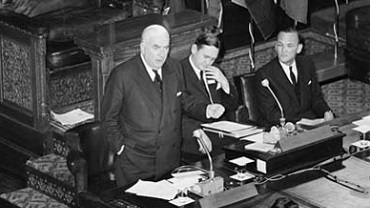When the Robert Menzies government legislated the Reserve Bank Act 1959, ALP politicians fought tooth and nail to defend the remaining powers of the Commonwealth Bank in its identity as a national bank for Australia. The Act was part of a suite of banking reforms which Menzies had been trying to pass since 1950, with the purpose—the Labor Party charged—of killing off the Commonwealth Bank. The Reserve Bank Act would completely separate the Commonwealth Trading Bank from the central bank (which became the Reserve Bank of Australia) in preparation for the “scrambling” of its operations, as one Labor senator noted at the time; the consolidation of control of both banks by private boards; and ultimately the trading bank’s sell off or shut down.
The economic mobilisation during WWII had displayed the power of the Commonwealth Bank to fund national development and pull the private banks into line, so after the war Prime Minister Ben Chifley attempted to lock in this capacity by making the Commonwealth Bank’s wartime powers permanent and then, when that didn’t work, by nationalising all the banks. By 1949 an unprecedented mobilisation by the City of London-centred Money Power, utilising the private banks, the Opposition and ultimately decisions of the High Court and Privy Council, had crushed that effort. The financial reforms of the Menzies government were determined to prevent nationalisation from ever being threatened again and to remove the possibility of Commonwealth Bank control over the private banks.
Nevertheless, even Menzies Liberals recognised the importance of government ultimately having control over the central bank. Senator William Spooner (Menzies’ Minister for National Development, who represented the Treasurer on that occasion) defended the retention of the section of the 1945 Commonwealth Bank Act which accorded the Treasurer authority over monetary policy, in the revised legislation (Section 11 of the 1959 bill). He stated: “Whilst a great measure of independence is to be given to this Reserve Bank, and whilst no government would lightly interfere with what it will do, in the final analysis the Government must reserve to itself the right to disagree with what the bank does. The Government should do that only in circumstances in which the disagreement is brought out before the Parliament so that all may see the effect of it.” The bank, he said, must function through a “co-operative effort by the banking system, the commercial community and the people of Australia” to protect currency stability, full employment and the economic prosperity and welfare of the people of Australia.
Prompted by a popular revolt among its base, the Coalition today has been persuaded to take a similar position on the latest rewrite of the RBA governing legislation, contained in the Treasury Laws Amendment (Reserve Bank Reforms) Bill 2023. If the Coalition sticks to its guns, with the Green and Crossbench votes the legislation will be blocked in its present form. Either the government amends the bill, or dumps it altogether to attempt to make the desired changes outside of the legislative arena.
The majority report of the Senate inquiry investigating the bill confirms it comprises a further devolution of Australia’s banking framework, building on the 1959 changes. The Reserve Bank Board (already separate to the Payments Systems Board) will be split into a Monetary Policy Board and a Governance Board. The key mandate of the existing RBA Board, to ensure its monetary policy decisions advance “the economic prosperity and welfare of the people of Australia”, would become an amorphous “overarching objective”. Thereby, the explicit objectives of the RBA are reduced to technocratic concerns that can be translated into the dry formulas and figures of economists: price stability, full employment and financial stability.
The majority report expresses the “significant interest” regarding the proposed repeal of Section 11, from both experts interviewed by the committee and the public. Despite the warnings of former RBA governors Ian Macfarlane and Bernie Fraser, and former Treasurer Peter Costello, that the removal of s.11 would leave the RBA without sufficient oversight by elected officials, and even that its removal may jeopardise RBA independence (for these arguments see “Parliament, senior experts rally to defend public power over RBA”, AAS, 28 Feb. 2024), the committee majority concluded that: “The RBA Reviewers and Treasury, however, provided assurance that removing s.11 would reinforce the independence of the RBA, align with the legislative settings of central banks of comparable jurisdictions, and give important preeminence to the Parliament in providing the check on RBA monetary decisions.”
The committee recommended that the bill be passed in full.
Minority reports
Coalition senators and Greens senators on the committee submitted dissenting reports.
Having reneged on its initial backroom deal with Labor—to support the RBA overhaul—and, more importantly, undermined the post-1983 bipartisan consensus on neoliberal economic policy, the Coalition went to great pains to justify its dissenting position.
The Coalition Senators declared that section 11 powers should be preserved. While restating their support for the independence of the RBA, the report noted that Section 11 was examined by the Campbell Committee’s Financial System Inquiry in 1981. Its final report stated that it “sees no need for change in the present provisions for resolution of differences of opinion between the Reserve Bank Board and the Treasurer (Section 11).”
The Campbell Committee said: “proposals to make the Bank fully independent of government would, in the Committee’s view, amount to the substitution of bureaucratic for political discretion which would be inconsistent with the processes of democratic government.” It concluded that the “ultimate determination of and responsibility for overall economic policy—including monetary policy—cannot be effectively divorced from government and Parliament.” Indeed, insisted the committee that launched the deregulation of finance in Australia, “the Bank cannot rise above the source of its powers—government and Parliament—and must be responsive to the direction which governments may deem fit to give”.
The Coalition report added that “the argument that section 11 is an impediment to [RBA independence] has not been effectively made”. The report recounts, at length, the arguments of numerous witnesses at the hearing, including RBA Governor Michele Bullock and Treasury representatives, who almost universally confirmed that s.11 does not harm RBA independence, and that the RBA is already operationally independent. The implication is: If s.11 hasn’t threatened independence operationally in the last 79 years, why on Earth would it now?
The Coalition concluded its position: “That the Bill be amended to maintain Section 11 of the Reserve Bank Act 1959.”
Don’t surrender to neoliberalism
The Greens slammed the effort to remove section 11 from the Reserve Bank Act, making the case against handing the power of elected governments over to unelected officials: “The proposal to remove section 11 from the RBA Act would remove the government’s power to protect mortgage holders and renters from unreasonable interest rate rises. It is a breathtaking attack on an essential democratic safeguard. ...
“Section 11 makes it clear that the ultimate responsibility for monetary policy lies not with unelected, unaccountable technocrats, but with a democratically elected government accountable to the people of Australia.”
It addressed other problems the RBA has contributed to, from unemployment to land price inflation. “Monetary policy is not and never has been a neutral mathematical exercise. The myth sustained by the RBA Review is that interest rate decisions are just a matter of getting the right data to the right people so they can, free of political influence, come up with the right number.
“The Treasurer’s enthusiasm to rid himself of the power to overrule an RBA decision is because he does not want to be blamed for massive increases in rents and mortgage repayments. ... It also insulates the RBA from accountability and allows it to pursue a narrow agenda that serves the interest of corporations and the financial sector over the broader welfare of the Australian people.”
Noting that the proposal arose from the RBA Review panel’s dialogue with experts, the Greens concluded that: “This is nothing less than a group of unaccountable neoliberal technocrats conspiring to further empower another group of unaccountable neoliberal technocrats. This is a perilously unsound foundation for such a consequential change to Australia’s democratic structures.
“Repealing Section 11 would be our democracy’s final surrender of monetary policy to the forces of neoliberalism.”
Greens push further: Save section 36!
The Greens also demanded section 36 of the Banking Act 1959 be retained in the new legislation. It “allows the Reserve Bank to direct how advances … should be used”. Such a tool would allow the RBA to target inflation more accurately than with interest rates alone.
The removal of s.36 “would further entrench the neoliberal ideology that commercial banks are the best arbiters of where capital should be directed. Unfortunately, as recent history shows us, this has turbocharged asset price inflation (particularly in speculative property and stocks) and substantially failed to support or advance productive economic activity.” They cited the COVID-era Term Funding Facility as an example of RBA money boosting property values rather than productive infrastructure or industries.
Unless ordered otherwise, “Commercial banks will not direct credit to where it best enhances society. They will direct it to where the risk is lowest, the returns are highest and the work is easiest—in other words, into property.” In his own submission to the inquiry, Greens Senator Nick McKim had noted that “Thirty years ago, Australian banks lent twice as much to business as they did for housing. Now they lend twice as much for housing as they do for businesses.”
Hinting at the potential to utilise the central bank as a national bank, the Greens’ report concluded that “Central banks should be able to direct the credit they create to parts of the economy that are productive, and away from those parts that are speculative. This is central to delivering economic prosperity and welfare to the people of Australia.”
By Elisa Barwick, Australian Alert Service, 27 March 2024









